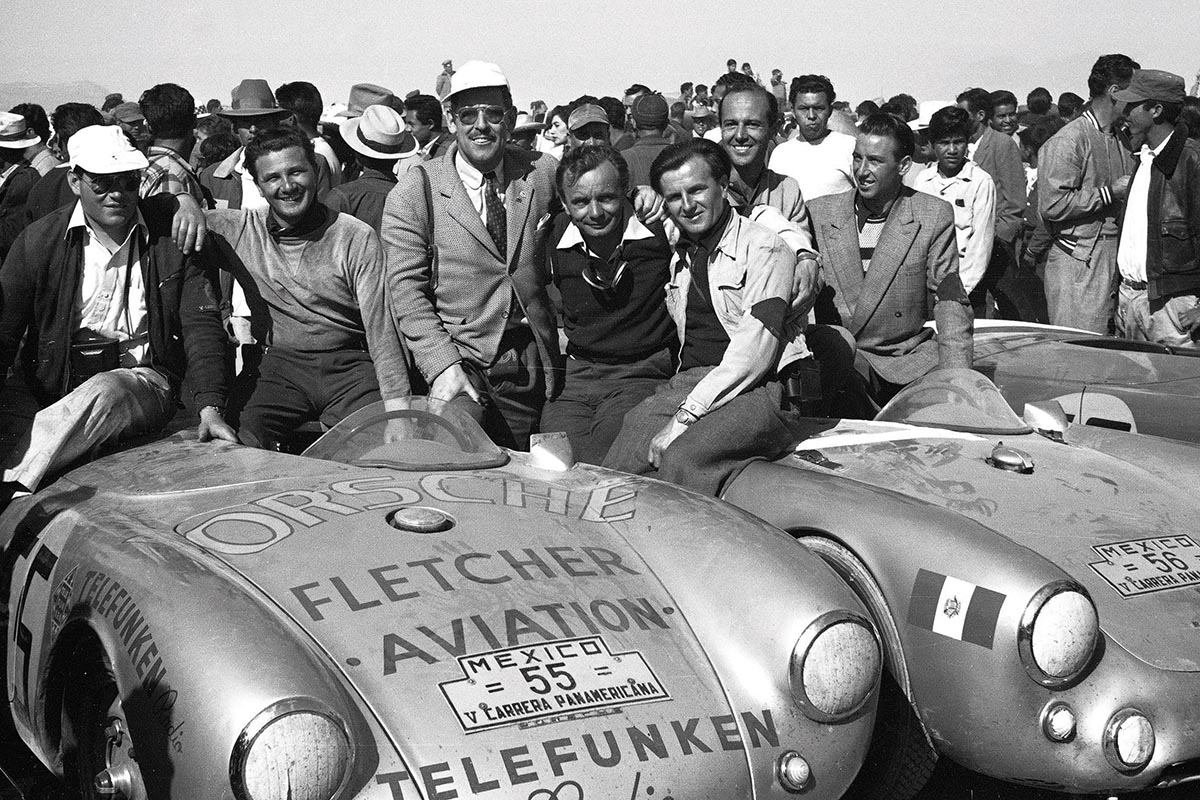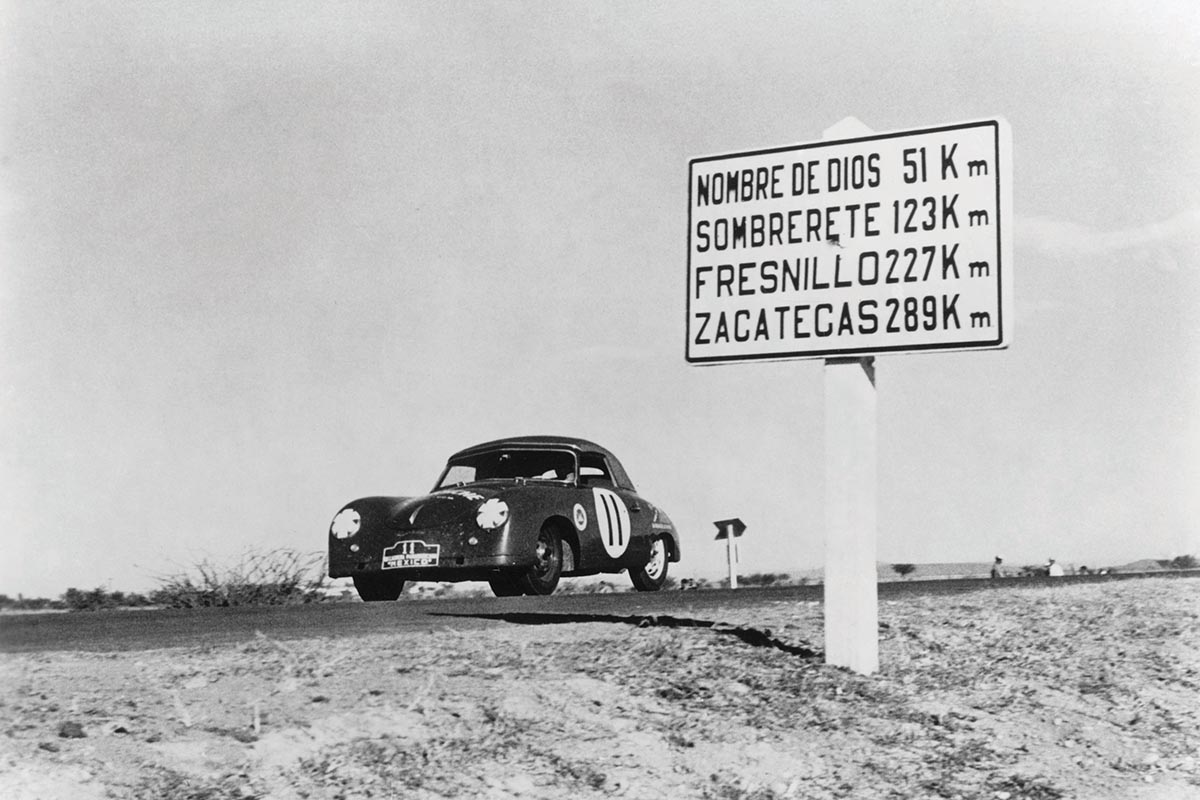It is odd that the word Carrera, Spanish for ‘race’, has been synonymous with Porsche for half a century and is almost as intrinsic as ‘911’ is to the wider perception of the brand. The first 911 to call itself Carrera was the RS 2.7 in 1973, before the decision to apply the moniker more generously was taken a decade later. At that point, the elevated origins of the word became even more muddied.
Porsche actually alighted upon it in the early 1950s when its fledgling factory was still producing modest numbers of 356As and struggling to gain the international prominence it needed to grow. Racing was regarded as the most direct route into the limelight and, following that famous class win at Le Mans in 1951, motorsport and PR polymath Huschke von Hanstein began eyeing up alternative avenues in other core markets.
The event that was garnering the most column inches in cash-rich North America at this point was the Carrera Panamericana, a point-to-point road race first run in 1950 to celebrate the completion of the north/south section of Mexico’s Pan-American highway. Run over five days and traversing just under 2200 miles of public road at altitudes of up to 10,000ft, the race was backed by the Mexican government in a bid to attract international business to the region.
With a starting point on the Texan border, Mexico had worked closely with the American Automobile Association to encourage a substantial contingent of US entrants and offered a huge prize pot to the winner. The 130-strong field in 1950 was comprised almost entirely of American sedans driven by amateurs and professionals alike. It was won, in a time of 27 hours and 34 minutes, by stock car drivers Hershel McGriff and Ray Elliott in an Oldsmobile 88.
The following year, the direction of the race was switched to allow the finish to occur on the US border and the start date moved to early winter to encourage more European entrants in their off season. Although that initiative failed by and large, it did attract Ferrari, who chose to mount the race’s first formal works campaign and took an easy outright win. This was enough to pique the interest of Mercedes, who cleaned up in 1952 with a pair of 300 SLs ahead of five further European entrants, and, finishing a lowly 25th overall and eighth in class that year was a privately entered 356 Super Cabriolet driven by, among others, Porsche factory mechanic Herbert Linge.
Back home, Porsche was busy designing and building its first purpose-built racing car. The Type 550 would debut at Le Mans in June 1953 as a fixed-head mid-engine coupé using an old-school push-rod 1495cc flat four beneath low-drag aluminium bodywork. A pair of prototypes finished first and second in class on debut in another astonishing feat for Porsche’s motorsport department and, following Linge’s experiences from the previous winter, it was agreed that the 550s would continue their development at the next Carrera Panamericana.
So highly regarded had the race now become that its fourth staging would also be recognised as the final round of the World Sportscar Championship. With this in mind, the two ex-Le Mans cars, which were to be raced by local privateers Jaroslav Juhan and José Herrarte Ariano, would be joined by a further two 550 coupés accompanied by the full works circus, complete with factory driver Hans Hermann and von Hanstein himself to oversee proceedings.
The 1953 Panamericana would prove to be a particularly brutal example of a race that had already earned itself a reputation for blood-letting, with nine fatalities overall including six spectators in a single incident. From 177 entries, there were just 60 finishers and the race was ultimately won by Juan Miguel Fangio in a Lancia D24. However, the 1600cc ‘Sport Menor’ class was taken by the 550 of Herrarte Ariano. The two factory-entered cars had DNF’d in quick succession due to mechanical failure, so von Hanstein immediately put the full might of his team at the disposal of the remaining customer car. Proxy win or not, Porsche was delighted.
Meanwhile, 6000 miles away in Stuttgart, the prototype programme was entering a new phase with the arrival of Ernst Fuhrmann’s four-cam engine. The famous Type 547, with its legendarily complicated four overhead camshafts and bevel gears, would be fitted to three more 550s – now in more familiar Spyder form – for the 1954 24 Hours of Le Mans. Two retired with mechanical gremlins, but the third would go on to win the S1.5 class for the second successive year.

With Porsche’s flag flying in Europe once more, attention was turned again to the Carrera Panamericana. Porsche took the decision not to travel to Mexico in a full factory capacity in 1954, but instead let its cars be entered by local teams while supplying Hans Hermann and Herbert Linge as lead driver and mechanic respectively. Still the final round of the World Sportscar Championship, the race had become not only markedly more professional but also far faster; the winning Ferrari of Umberto Maglioli averaged 138mph over a 227-mile stage
at one point and finished 10 hours earlier than McGriff did in 1950.
Despite this, the tiny four-cam Porsches showed their mettle amid a sea of American V8s and Italian V12s and finished third and fourth overall, beating cars that doubled or tripled their cylinder count and displacement. The lead Spyder of Hermann and Linge, equipped with a Fuhrmann engine, averaged just under 100mph across the entire race and crossed the line more than an hour ahead of the third-placed finisher in the 1500cc class.
But tragedy remained a constant on the Carrera Panamericana. Seven further fatalities in 1954, including two more spectators, brought the death toll to 27 in just five years. Following the devastating accident that would occur at Le Mans the following summer, the decision was taken by the Mexican government to cancel the event for good.

The name Carrera, however, was already part of the Porsche vernacular. Adopted in honour of Herrmann’s remarkable drive as the signature of its future racing cars, it was applied to a succession of 356 models fitted with the Fuhrmann engine right up until the arrival of the 911 in 1963. By then, of course, the Panamericana was long forgotten, with the Targa Florio filling the gap on the World Sportscar Championship calendar and providing the next enduring idea for the marketing men of Zuffenhausen…